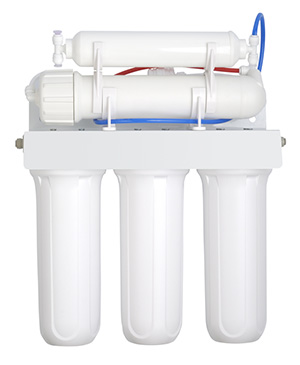Leak Testing Domestic Water Purifiers

Domestic water purifier
A water purifier can be small for domestic use, or bigger for groups of apartments. The purpose is to make potable water from tap water by filtering the incoming water. The purifier consists of typically 3-5 filters in the shape of cylinders that are connected with quick-connectors and plastic tubes. All are housed in a cabinet. Filter cartridges are replaceable by the user.
Components may be pressurized with water and then placed on pieces of paper. The approximate location of the leak will become evident to the operator as the paper gets wet. Typical test time for this process is 15 minutes.
The leak testing of assembled water purifiers is done by pressurizing the component with air 4-5 barg followed by mainly water bath or soaping. Typically 10-15 points need leak testing. The soap is applied in foam shape and allowed to de-foam for 2-5 minutes. Each joint is then inspected visually, which usually takes between 5-15 seconds. The negative effects of soaping are:
- In presence of large leaks the soap spray can be blown away from the leak site, and in the case of small leaks the soap spray is difficult to see. Therefore, both types of leak can be missed.
- The leak limit normally used means that manufacturers reject products that would not leak water. It costs money to produce over-quality.
- It is questionable if an operator can see the circumference of 10-15 joints well enough to detect each leak.
- Because the soap needs to “sit” for 2-5 minutes, there is a need for space to store a number of purifiers that are in this waiting mode.
- For the same reason as above, there is a backlog of products that compromises production and increases capital cost.
The INFICON Solution
Leak testing assembled water purifiers
Sensistor Sentrac Hydrogen Leak Detector and TGF11 Tracer Gas Filler
Before leak locating, the purifier is filled with tracer gas 5%H2/95%N2. Filling the purifier with tracer gas should be done in a way that ensures a maximum concentration of tracer gas on the inside. This can be done by evacuating the air before filling, or filling through one port and evacuating through a port at the far end at the same time. Just pushing in tracer gas at 4 barg is also an option, but one must ensure that the gas reaches all parts of the product and be aware that gas mix will be diluted with air on the inside, thus reducing sensitivity. Additionally, not all products are fit for the push-in technique, due to complex geometries on the inside.
Once the filling is done, the leak testing can start. A Sensistor Sentrac Hydrogen Leak Detector with hand probe is used to detect leaking tracer gas at the joints of interest. Since the leaks operators are looking for (water tight) are releasing quite high concentrations of tracer gas, it will be enough to point test each joint, which will need approximately 1 second per joint. This includes moving the probe between joints.
Release of tracer gas must take place where contamination of the test station can be avoided. Additionally, the area should also allow the filling equipment to evacuate. However, sometimes the testing takes place on a moving conveyor belt which creates a need for separate evacuation equipment.
Benefits of Hydrogen Leak Testing
- Fast pin-pointing of the leak position
- No operator interpretation of the leak size - precise measurement obtained
- Repair only the leaks that are leaking above the reject level
- No time wasted in cleaning up or drying after testing
- All leaks detected even in hard to access areas, reduces operator dependence
- No pile-up of waiting products saves space and capital
For best leak limits and more detailed information about leak testing water purifier contact the INFICON sales office nearest to you.